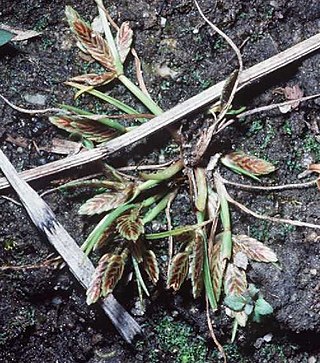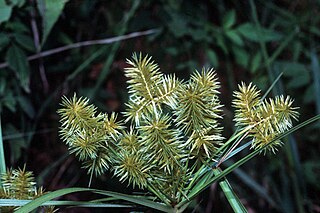
Cyperus is a large genus of about 700 species of sedges, distributed throughout all continents in both tropical and temperate regions.

Cyperus polystachyos, also known as Pycreus polystachyos, and also called manyspike flatsedge in the US, or bunchy sedge, coast flatsedge, many-spiked sedge or Texas sedge in Australia, is a herbaceous species in the family Cyperaceae, widespread in tropical and subtropical areas around the world, sometimes extending its range into temperate regions.

Cyperus eragrostis is a species of sedge known by several common names, including tall flatsedge, nutgrass, tall nutgrass, umbrella sedge, chufa, Earth almond, zula nuts, edible galingale and pale galingale.

Cyperus acuminatus is a common species of sedge known by several common names, including tapertip flatsedge and pale umbrella-sedge. This plant is native to North America, where it is widespread across the Great Plains and the western United States, with scattered populations in the eastern US as well as in Saskatchewan, Tamaulipas and Coahuila.

Cyperus bipartitus, commonly known as slender flatsedge, river cyperus, or the shining flatsedge, is a common species of sedge. The name "slender flatsedge" also applies to Cyperus gracilis.

Cyperus difformis is a species of sedge known by several common names, including variable flatsedge, smallflower umbrella-sedge and rice sedge. This plant is native to southern Europe, most of Africa and Asia, and Australia, and it is naturalized in other areas of the world, including large parts of the Americas.

Cyperus erythrorhizos is a species of sedge known by the common names red-rooted flatsedge or redroot flatsedge. It is found across much of North America from Maine, Ontario and British Columbia south to Tabasco in southern Mexico.

Cyperus fuscus is a species of sedge known by the common name brown galingale, or brown flatsedge. This plant is native to much of Europe, Asia and North Africa from England, Portugal and Morocco east to China and Thailand. It is an introduced species in North America, where it is naturalized in widely scattered locations in the United States and Canada.
Cyperus niger is a species of sedge known by the common name black flatsedge. This plant is native to the Americas, where it can be found in wet areas from South and Central America to the southwestern United States, from California and Oklahoma south to Argentina.

Cyperus odoratus is a species of sedge known by the common names fragrant flatsedge and rusty flatsedge. This species is quite variable and may in fact be more than one species included under one name.

Cyperus squarrosus is a species of sedge known by several common names, including bearded flatsedge and awned flatsedge. It is found in wet environments in North and South America, Africa, Australia, southern Asia and Italy.

Cyperus laevigatus is a species of sedge known by the common name smooth flatsedge.
Cyperus parishii is a species of sedge known by the common name Parish's flatsedge. It is native to the southwestern United States and northwestern Mexico. It grows in desert, mountain, and coastal habitat in Sonora, southwestern New Mexico, Arizona, southern Nevada and southern California. It is an annual sedge forming small clumps up to about 25 centimeters tall. The inflorescence is a spherical cluster of up to 30 reddish spikelets with a few long, leaflike bracts at the base.

Cyperus strigosus is a species of sedge known by the common names false nutsedge and straw-colored flatsedge. It is native to the United States, Cuba and Canada, where it grows in wet areas in many habitat types, including disturbed and cultivated areas such as roadsides and crop fields. It is common and sometimes weedy. It is a perennial sedge growing up to 70 centimetres tall. The inflorescence is a cluster of many linear-shaped spikelets up to 3 centimetres long each. A few long, leaf-like bracts grow at the base of the spike.
Cyperus cuspidatus, commonly known as the coastal plain flatsedge, is a sedge of the family Cyperaceae that is native to seasonally dry tropical areas of Africa, Asia, the Americas and Australia.
Cyperus digitatus, also known as finger flatsedge in the United States, and chang xiao sui suo cao in China, is a sedge of the family Cyperaceae that is native to tropical and subtropical areas of Africa, Asia, the Americas and Australia.

Cyperus javanicus, also known as the Javanese flatsedge, is a sedge of the family Cyperaceae that is native to Indonesia and Australia.

Cyperus surinamensis, also known as the tropical flatsedge, is a sedge of the family Cyperaceae that is native to the Americas.

Cyperus tenellus is a sedge of the family Cyperaceae commonly known as the tiny flatsedge.
Cyperus zollingeri, commonly known as roadside flatsedge, is a sedge of the family Cyperaceae that is native to tropical areas of Australia, Africa and Asia.















